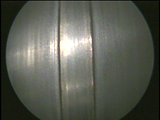I have a bore-scope in the shop and have watched what happens while breaking in a barrel. I have also noted that some barrels benefit more from a careful break-in than others.
The fact that a shooter from yesteryear says that barrel break-in is unnecessary and tells a little story to back up his ignorance up means - just that.
I have a Mosin-Nagant that looks "all nice and shiny" if you peek down the bore. The bore-scope though reveals what looks a lot like sewer pipe, currently in use. Peeking down the bore tells you very little if anything about the actual condition of a rifle bore except in very extreme cases. - It does though serve to make shooters who do not want to clean the gun properly feel better about their negligence.
"All I do is run a patch wet with gun oil down the bore every 200 rounds, and when I peek down the bore, it looks all shiny like new!"
Duh.
My most accurate rifle is a heavy-barreled Savage in .243 Winchester. When I first got the gun and bore-scoped the barrel I almost sent it back, because chatter from the button-rifling made it look like corrugated iron.
 Click image to see it larger
Click image to see it larger
But I kept it, and gave it a thorough break-in, removing copper and carbon every shot for twenty rounds, then every 5 shots for twenty, then every ten shots for forty - and every twenty rounds thereafter.
Five round, 1/2" groups from this gun are now pretty much the norm. - It didn't start off that way, but after break-in it has been consistently accurate.
Shooters who brag about how accurate their gun is without barrel break in have no way of knowing how much MORE accurate it might have been if treated properly.
On the other hand, my Browning BLR did not really benefit much from break-in... Here's why:

It started off as smooth as a baby's bottom, so just keeping it reasonably clean was the only attention it required. That's the good news... The bad news is that the BLR's accuracy did not improve as more rounds went through it.
Note that a little roughness in the bore, as in the case with my Savage, can be conducive to accuracy.
There was a famous case which will illustrate how this happens. In the 1960's Rolls-Royce purchased rights to manufacture an automatic transmission design from General Motors. The Rolls-Royce engineers noted that one of parts had a generous tolerance for roughness and decided to make that part better, smoother than GM specified.
The transmission they built would not work properly though, and after consulting with GM they discovered that the roughness on that part actually made it operate much more smoothly.
Aircraft manufacturers have noted that in many situations, an ultra-smooth skin on the fuselage and wings will actually introduce drag. Apparently the air collects in imperfections on the metal so that the slipstream rides upon air instead of metal, thus reducing drag.
If you think about it, the bullet touches a lot less metal while riding through the 'corrugated' bore of my tack-driver Savage than it does in the bore of my smooth as a baby's butt BLR, which has never shot into less than two inches.
The extreme, inconsistent roughness of my sewer-pipe Mosin though is not conducive to accuracy. - The thing shoots into 4" at 100 yards - on a good day if I hold my mouth just right.
Just sayin'...


